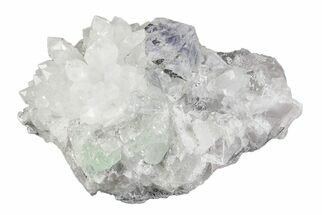This Specimen has been sold.
6.8" Blue Fluorite, Quartz, Pyrite - Fujian Province, China
This is a beautiful specimen of fluorite and quartz from Fujian Province, China. There are small pyritohedron inclusions as well as some tiny pyrite cube clusters in the matrix.
Silicon Dioxide, also know as SiO2 or Quartz, is the second most abundant mineral in the Earth's crust. Quartz crystals generally grow in silica-rich, hot watery solutions called hydrothermal environments, at temperatures between 100°C and 450°C, and usually under very high pressure. Quartz veins are formed when open fissures are filled with hot water during the closing stages of mountains forming, and can be hundreds of millions of years old.
About Fluorite
Fluorite is a halide mineral comprised of calcium and fluorine, CaF2. The word fluorite is from the Latin fluo-, which means "to flow". In 1852 fluorite gave its name to the phenomenon known as fluorescence, or the property of fluorite to glow a different color depending upon the bandwidth of the ultraviolet light it is exposed to. Fluorite occurs commonly in cubic, octahedral, and dodecahedral crystals in many different colors. These colors range from colorless and completely transparent to yellow, green, blue, purple, pink, or black. Purples and greens tend to be the most common colors seen, and colorless, pink, and black are the rarest.
Fluorite is a halide mineral comprised of calcium and fluorine, CaF2. The word fluorite is from the Latin fluo-, which means "to flow". In 1852 fluorite gave its name to the phenomenon known as fluorescence, or the property of fluorite to glow a different color depending upon the bandwidth of the ultraviolet light it is exposed to. Fluorite occurs commonly in cubic, octahedral, and dodecahedral crystals in many different colors. These colors range from colorless and completely transparent to yellow, green, blue, purple, pink, or black. Purples and greens tend to be the most common colors seen, and colorless, pink, and black are the rarest.
Silicon Dioxide, also know as SiO2 or Quartz, is the second most abundant mineral in the Earth's crust. Quartz crystals generally grow in silica-rich, hot watery solutions called hydrothermal environments, at temperatures between 100°C and 450°C, and usually under very high pressure. Quartz veins are formed when open fissures are filled with hot water during the closing stages of mountains forming, and can be hundreds of millions of years old.
SPECIES
Fluorite
LOCATION
Fujian Province, China
SIZE
6.84x4.17"
CATEGORY
SUB CATEGORY
ITEM
#31587
 Reviews
Reviews

















